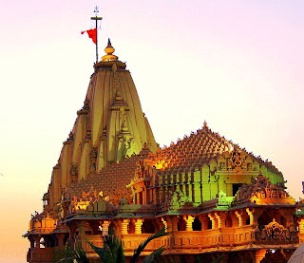 Somnath temple is one of the most important temples in the country and is considered Aadi or the first of the twelve “Jyothirlingas”. The Sivalinga here is Swayambhu or Natural formation. Somnath temple was referred to in many ancient texts and is one of the richest temples of those times. The wealth of the temple attracted a lot of muslim invaders who looted and plundered its vast wealth and even destroyed the temple. But the faith in the Lord remains to this day and quite rightly so because the Lord here is giver of peace and prosperity and is known to fulfill his devotees desires. The place is so sacred to Hindus that many great personalities from our puranas and other ancient texts are said to have worshipped at this place. Lord Sri Krishna is said to have performed his Neejdham Prasthan Leela at the banks of the holy river hiran here. Parasurama is said have performed a penance at the Parasuram Tapobhumi here. The Pandavas have also visited the place and worshipped the Lord by building five temples here.
Somnath temple is one of the most important temples in the country and is considered Aadi or the first of the twelve “Jyothirlingas”. The Sivalinga here is Swayambhu or Natural formation. Somnath temple was referred to in many ancient texts and is one of the richest temples of those times. The wealth of the temple attracted a lot of muslim invaders who looted and plundered its vast wealth and even destroyed the temple. But the faith in the Lord remains to this day and quite rightly so because the Lord here is giver of peace and prosperity and is known to fulfill his devotees desires. The place is so sacred to Hindus that many great personalities from our puranas and other ancient texts are said to have worshipped at this place. Lord Sri Krishna is said to have performed his Neejdham Prasthan Leela at the banks of the holy river hiran here. Parasurama is said have performed a penance at the Parasuram Tapobhumi here. The Pandavas have also visited the place and worshipped the Lord by building five temples here.
History and Legends
The history of this ancient temple is full of ups and downs during the second millennium. The temple is a major pilgrim center for much of its existence since pre historic times according the Hindu Mythology. The temple can be traced back to the mythological Satya Yuga, the first of the four Yugas. There are as many as seven temples that were built at this sacred site owing to destructions by muslim fundamentalist attackers. The present temple is the seventh reconstruction and was reconsecrated on May 11, 1951. The great Sardar Vallabhai Patel was behind the movement to reconstruct the temple that was in ruins.
Origins of other reconstructions can be traced back to 649 AD when the Yadava Kings of Gujarat built the temple. The temple was reconstructed around 815 AD after being destroyed by an Arab Governor in 725 AD. The temple was under attacks again in the years 1024 , 1297, 1394 and 1706 respectively. Each time this holy temple was destroyed by fundamentalists like Mohamed Ghazni and Aurangazeb, the temple was reconstructed with renewed spirit by ardent devotees. Such is the love and respect that Lord Someshwar commands. The Temple was once very wealthy and was looted by muslim invaders time and again. Ahilya Bai Holkar, Queen of Indore also built a temple at this place around 1782 AD. She was a great devotee of Lord Shiva and helped in the reconstruction of many ancient temples in the country.
Skanda Purana has it that the Moon God was married with twenty-seven daughters of Daksha Prajapathi. The Moon God used to share his love only with his wife Rohini and neglected all other wives. This made them feel insulted and uncared for. Apparently, Daksha Prajapathi was furious about this partisan behaviour by his son in law and cursed him whereby, the Moon God will have shed his size by the day. This depressed the Moon God very much and he decided to do Penance for Lord Shiva at this place. An Impressed Lord granted him a boon whereby the Moon God will only have to shed his size for just the first half of the month and can reclaim the size shed by him gradually during the second half. A very pleased Moon God constructed the temple here with gold to honor Lord Shiva. The Lord is called Somnath after the legend of Moon God. The temple is also constructed by Ravana with Silver and Lord Krishna with Sandalwood during the Thretha Yug and Dwapara Yug respectively. Thus, the history of the temple dates back to pre historic times.
Places of Interest
The Bhalka Theerth where Lord Krishna pardoned a hunter when hit with his arrow and the Dehotsarg Theerth are important attractions and places of religious significance. The Dehotsarg Theerth, located at a distance of 1.5 kilometers from the main temple is the place where Lord Krishna performed his Neejdham journey and is mentioned in many ancient texts like Srimad Bhagavat. The place is marked by the Lord’s foot print and is considered ultra holy. Dehotsarg Theerth is also home to the Lakshmi Narayan Temple and the Geetha Mandir. The nearby Balaramji ki Gufa is also a significant attraction. The Triveni Sangam or the confluence of the holy rivers Hiran, Kapila and Saraswathi is a very sacred place and a holy dip here is what pilgrims long for, as it grants salvation.
Festivals
Mahasivaratri in February/March is celebrated with great fervor and so are Diwali and Dushera around September/October.
Accommodation
The Shree Somnath Trust administers several Guesthouses and dormitories and can be booked by contacting the guesthouse manager, Shree Somnath Trust. Additionally there are some options to choose from in Veraval.